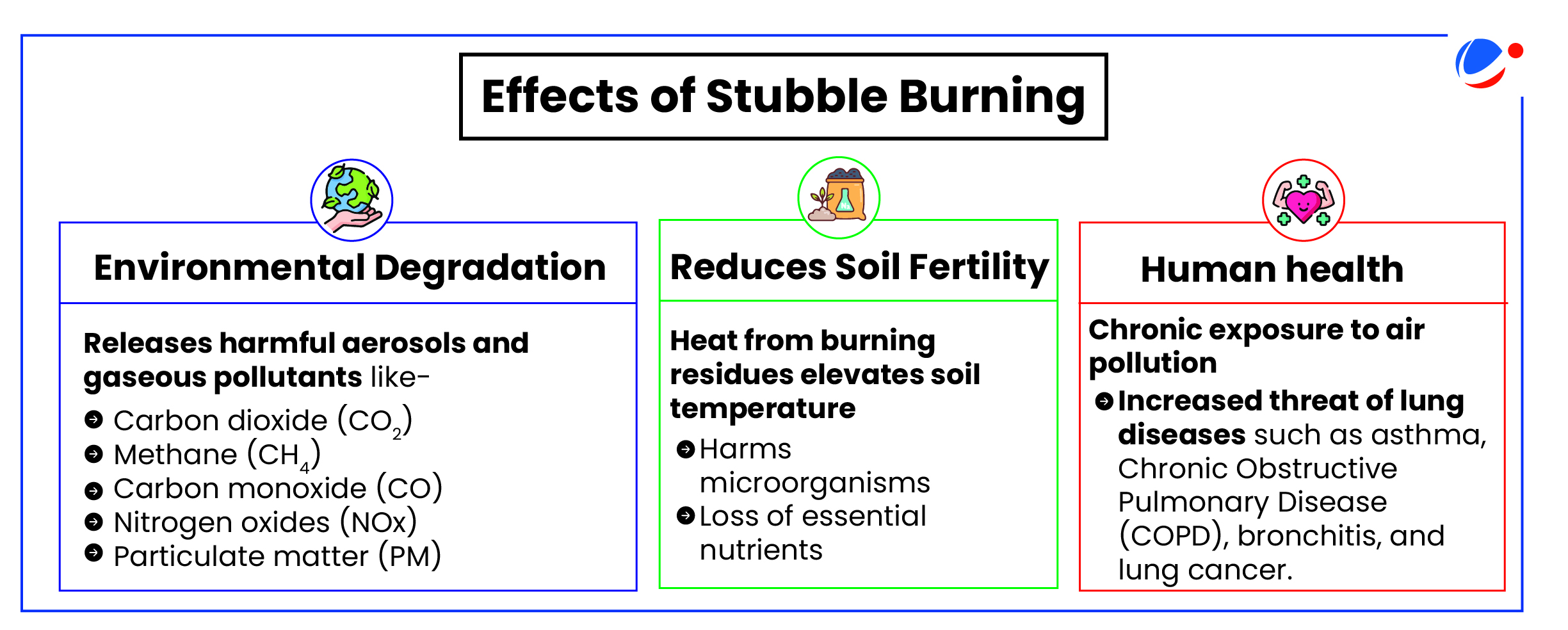Why in the news?
A parliamentary standing committee has recommended introducing a minimum support price (MSP) for paddy residue to discourage stubble burning, one of the main causes of air pollution in Delhi.
More on the news
- The recommendations were made by the Committee on Subordinate Legislation which examined the Commission for Air Quality Management (CAQM) in National Capital Region and Adjoining Areas (Imposition, Collection and Utilization of Environmental Compensation for Stubble Burning) Rules, 2023.
- The rules were notified under the CAQM Act, 2021 to deal with the problem of stubble burning and fulfil the provision of Section 15 of the Act.
About Stubble Burning
- A stubble burn refers to the act of setting on fire straw that has been left over after the harvest of grains, such as paddy, wheat, etc.
- Stubble burning (parali) is used to remove Paddy crop residues from fields in preparation for sowing wheat, which is done around the end of September and the beginning of November.
- Punjab, Haryana, and Uttar Pradesh are the primary states where this practice is prevalent during this time of year.
- Reasons for stubble burning: Cheaper than alternative disposal methods, weed management, pest control etc.

Challenges in controlling stubble burning
- Technical and Infrastructural Challenges
- Inadequate harvesting technology: Current combine harvesters leave 10-15 cm stubble that cannot be easily removed.
- Limited storage infrastructure: Lack of large land parcels for safe storage of paddy straw as well as limited availability of custom hiring centers, especially for small farmers.
- Inadequate supply chain support: From companies collecting stubble
- Wear and tear on machinery: Technical difficulties in using 100% paddy straw as feedstock due to high silica content causing wear and tear on machinery
- Short window (15-20 days): between harvesting rice and sowing wheat crops.
- Regulatory and Administrative Challenges
- Ambiguity in definitions: Of key terms like "stubble burning" and "environmental compensation".
- Unclear procedures: For the "RED ENTRY" system marking non-compliance with the rules related to stubble burning.
- Lack of exit provisions for removing red entries from farmers' records
- Insufficient coordination: Between multiple ministries and state governments.
- Financial and Economic Barriers
- Insufficient subsidies for widespread adoption of machinery
- Lack of proper utilization frameworks: For environmental compensation fund.
- Socioeconomic and Awareness Issues
- Insufficient education and training programs on alternative methods and sustainable farming
- Imbalance between punitive measures and positive incentives.
Steps taken by government to reduce stubble burning
|
Way Forward: Recommendations made by Parliamentary standing committee
- Financial Framework and Support Systems: Create a price system similar to Minimum Support Price (MSP) to guarantee returns when farmers sell stubble
- Review and notify benchmark prices annually before the Kharif harvest season.
- Ensure prices reflect farmers' actual costs for residue collection, including labor and machinery.
- Technical and Infrastructure Development
- Establish a Real-time Mapping of Crop Acreage and Forecasting of Crop Maturity to assess district-wise crop yields for better planning.
- Create interim storage facilities in districts where industries or end users are unavailable within 20-50 km.
- Support local entrepreneurs and aggregators and develop supply chain infrastructure.
- Regulatory and Administrative Improvements
- Designate a specific authority to address farmers' grievances in a time-bound manner
- Provide clarity through necessary amendments in existing rules.
- Introduce an incentive-based Red Entry removal system for farmers participating in sustainable practices
- Incorporate a new sub-rule for proper utilization of Environmental Compensation Fund for stubble burning.
- Agricultural Practice Improvements
- Incentivize adoption of short-duration paddy varieties as alternatives to long-duration varieties like PUSA 44
- Standardize procurement processes for alternative crop varieties and enforce seed certification bans for problematic varieties
- Coordination and Policy Integration: Unified National Policy for integrating agricultural residue into bioenergy generation which
- Prioritize adoption of technologies like bioethanol, compressed biogas, and biomass pellet.



